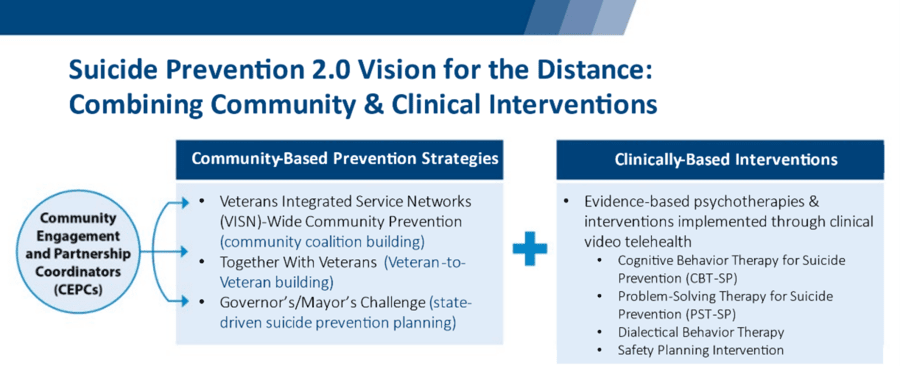Community Based Interventions for Veteran Suicide Prevention
By Christina Mariani, LMSW, CAADC, Community Engagement and Partnership Coordinator, Detroit Veterans Health Administration and Katrina BeShears, LMSW, CAADC, Community Engagement and Partnership Coordinator, Detroit Veterans Health Administration
The mental health challenges faced by Veterans are pressing and multifaceted, necessitating a proactive and coordinated response to prevent suicide. Many Veterans lose their lives to suicide each year, and it is essential to foster environments that prioritize their well-being. This involves engaging a network of support systems, services, and resources that work collaboratively to address the unique challenges Veterans encounter.
The factors that contribute to suicide deaths are multiple and complex. Preventing these deaths requires that support systems, services, and resources work together to promote wellness and help Veterans successfully navigate these challenges. Clinical and community-based programs and services play a key role in promoting wellness, building resilience, and preventing suicidal behaviors among Veterans. The Columbia-Suicide Severity Rating Scale (C-SSRS) is an example of an evidence-based suicide risk assessment tool used by VA and non-VA health care systems, as well as in other community and clinical settings. A wide range of community partners also have an important role to play in delivering prevention programs and services to Veterans at the local level. These community-based professionals and organizations should be competent in serving Veterans in a way that is culturally appropriate and uses their preferred language. Greater coordination among community and clinical preventive service providers and VA health care providers can have a synergistic effect in preventing Veteran suicide and related behaviors.
The VA’s program goals and interventions are listed below:
- Develop, implement, and monitor effective programs that promote wellness and prevent Veteran suicide and related behaviors.
- Strengthen the coordination, implementation, and evaluation of comprehensive Veteran suicide prevention programming.
- Encourage community-based settings to implement effective programs and provide education that promote wellness and prevent Veteran suicidal behaviors.
- Deliver interventions to reduce suicidal thoughts and behaviors among Veterans with suicide risk.
- Strengthen efforts to increase access and delivery of effective programs and services for mental health disorders.
- Promote efforts to reduce access to lethal means.
- Encourage providers who interact with Veterans at risk for suicide to routinely assess for access to lethal means.
- Partner with firearm dealers and owner groups to incorporate suicide awareness as a basic tenet of firearm safety and responsible firearm ownership.
- Provide training to community and clinical service providers on suicide prevention.
- All community-based and clinical professionals whose work brings them into contact with Veterans should be trained on military culture, how to address suicidal thoughts and behaviors, and how to respond to those who have been affected by suicide.
- Provide training on suicide prevention to community groups that have a role in the prevention of Veteran suicidal behaviors.
- Provide training to mental health providers on the recognition, assessment, and management of at-risk behavior among Veterans, and the delivery of effective clinical care for Veterans with suicide risk.
- Promote the adoption of core education and training guidelines on the prevention of Veteran suicidal behaviors by all health professions, including graduate and continuing education.
- Promote the adoption of core education and training guidelines on the prevention of Veteran suicidal behaviors by credentialing and accreditation bodies.
- Develop and disseminate protocols and programs for clinicians and clinical supervisors, first responders, crisis staff, and others on how to implement effective strategies for communicating and collaboratively managing Veteran suicide risk.
This is how the VA operationalizes their approach in small- and large-scale action steps:

The Detroit VA Healthcare System partners with the statewide Michigan Veterans Affairs Agency through three key priority areas within the Governor’s Challenge: 1. Identifying Service Members, Veterans, and their Families and screening for suicide risk i.e. the Veteran Connector Program to encourage community businesses and organizations to ask patrons “Have you ever served in the Military?” and assist with connecting them to services. 2. Improve care transitions and encourage connection i.e. promoting 988 in local parks on selfie stands, as well as on hunting and fishing licenses distributed by the state. 3. Lethal means mitigation and safety planning i.e. trainings, outreach to firearms dealers and ranges, CPL courses, etc. for education and promotional opportunities.
VA’s Community Engagement and Partnership Coordinators (CEPCs) participate and provide technical assistance to community Suicide Prevention Coalitions and Task Forces with shared goals.
VA provides gunlocks for local organizations and clinics to distribute to clients/patients/consumers.
Detroit VA builds and distributes Discharge Toolkits to Veterans upon discharge from the inpatient mental health unit with resources, contact information, branded merchandise, and medication disposal envelopes, as well as Lethal Means Kits that are mailed to Veterans identified as at an increased risk for suicide and benefiting from an enhanced level of care.
VA’s CEPCs facilitate relevant community conversations that impact Veterans and Military, and their Families, as well as providing evidence-based suicide prevention trainings to populations that intersect with Veterans and their families.
In conclusion, addressing Veteran suicide requires a comprehensive and collaborative approach that includes education, training, and accessible resources. By leveraging community partnerships and enhancing service coordination, we can create a supportive environment that fosters resilience and encourages Veterans to seek help. Together, we can make significant strides in reducing the incidence of suicide among Veterans, ensuring they receive the care and support they deserve.
